If you do
NOT see the Table of Contents frame to the left of this page, then
Click here to open 'USArmyGermany'
frameset |
1st Missile Command
Southern European Task Force
Looking for more information from military/civilian
personnel assigned to or associated with the U.S. Army
in Germany from 1945 to 1989. If you have any
stories or thoughts on the subject, please contact me . .
|
|
|
|
|
|
| 1st Missile Command |
|
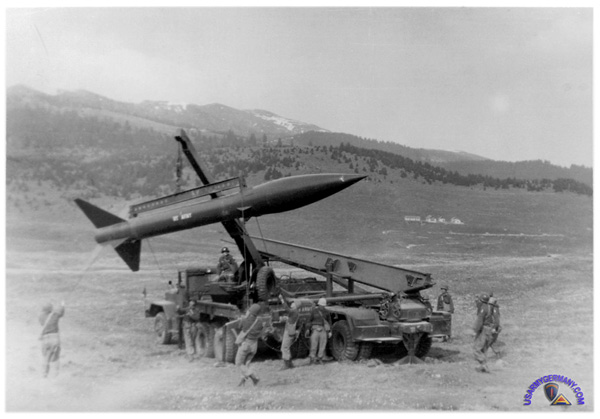
Honest John of 510th FA Rocket Bn at a training area in the Italian Alps (Norman Farrell) |
|
| (Source: The Organizational History of Field Artillery, 1775-2003, by Janice E. McKenney, CMH) |
By the end of 1958, a different kind of combined arms organization appeared in the Army in addition to the corps and division. When the Southern European Task Force was organzied in 1955 at Leghorn, Italy, the Army soon realized that new concepts of organization were necessary. Although the force was organized as a combined arms organization, its primary arms organization was not a maneuver element, but the Honest John battalion.
Missile commands, based on experiences gained from the Southern European Task Force, were developed to provide accurate all-weather firepower for the United States and its allies.
The 1st United States Missile Command was organized as a "medium" missile command, built around the Honest John rocket and the Corporal missile.
The medium commands were the largest and most flexible, each numbering approximately 5,000 officers and men and, under tentative tables, having a headquarters and headquarters company, a field artillery rocket group with up to four Honest John battalions, a Corporal battalion, an engineer combat battalion, an armored infantry battalion for local security, a "sky" cavalry squadron for target acquisition, a signal company, and a service and supply group. Their mission was not to replace army or corps artillery but to augment them by supplying rocket and missile firepower to supplement conventional armament.
The 1st Missile Command, a major component of SETAF, was operational in Italy between 1957 and 1965. The command was not organized precisely as outlined in the medium missile command tables. The 1st originally had two Honest John battalions and two Corporal battalions, but no group headquarters.
In 1969, the 1st - which had turned over its Honest John to the Italian army in 1959 - was reorganized around the Sergeant missile - the Corporal's replacement. The new structure consisted of a headquarters and headquarters company, a Sergeant battalion, a transportation detachment for aircraft repairs, an engineer company, an aviation company for surveillance, and an ordnance battalion. |
|
|
| 1958 |
(Source: STARS & STRIPES, June 11, 1958) |
Some of the units attached to the 1st Missile Command in June 1958:
 159th FA Rocket Bn 159th FA Rocket Bn
 510th Rocket Bn 510th Rocket Bn
 543rd FA Missile Bn 543rd FA Missile Bn
 570th FA Missile Bn 570th FA Missile Bn
 1st Provisional Bn (includes 124th Sig Co) 1st Provisional Bn (includes 124th Sig Co)
 52nd Armd Inf Bn 52nd Armd Inf Bn
 Ord Bn (Prov) Ord Bn (Prov)
 Engr Bn (Prov) Engr Bn (Prov)
|
|
The 159th and 510th FA Rocket Bns are equipped with the 762mm HONEST JOHN free-flight rocket; the 543rd and 570th FA Missile Bns are equipped with the CORPORAL guided missile. |
|
|
1959 |
(Source: STATION LIST, 17 August 1959) |
| ORGANIZATION (Aug 1959): |
| |
UNIT |
|
STATION |
|
| |
Hq/Hqs Company, 1st MSL Comd (Med) |
|
Vicenza |
|
| |
1st MSL Bn (CPL), 80th Arty |
|
Vicenza |
|
| |
1st MSL Bn (CPL), 82nd Arty |
|
Vicenza |
|
| |
124th Sig Co (MSL Comd) |
|
Vicenza |
|
| |
Hq/Hq Det, Sup Gp, 1st MSL Comd (Med) |
|
Vicenza |
|
| |
574th QM Co (Sup & Svc) |
|
Vicenza |
|
| |
328th Ord Bn (Atomic Spt Comd) |
|
Vicenza |
|
|
|
|
(Source: MISSILES AND ROCKETS, 13 July 1959) |
Missile Troops in Italy
by Charles Newton
The following dispatch was sent from Italy by M/R's Executive Editor, now touring Europe.
VICENZA - The Western World's first army missile command is stationed here as part of NATO-earmarked forces which are armed with obsolete weapons, recently reduced in strength by half - and still a potent force because of the "mystery of atomic power."
The missile unit is part of the Southern European Task Force (SETAF) and operates under the command of Col. Melville B. Coburn. Up until June of this year it had been armed with the Corporal missile and the Honest John rocket, both with nuclear warheads. On June 30 - by coincidence, perhaps, the end of the U.S. fiscal year - the two Honest John battalions were formally turned over to the Italian army, which had been training to use them since Jan. 1. Simultaneously, the command's personnel was cut in half, from 4000 to 2000.
"The fact that we have obsolete or at least obsolescent weapons is not important to the people of Italy," Coburn said. "To them SETAF is a manifestation that there is an atomic force in Italy and that it is here to stay. It is a part of the mystery of atomic power." |
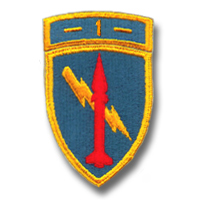 1st Missile Command Patch
1st Missile Command Patch
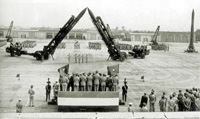
Corporals arrive at Vicenza, 1955
|
|
He recalled that last October his Army command loaded an Honest John into two USAF planes - a C-124 and C-130 - one carrying the rocket and the other support equipment, and flew it to Salonika, Greece. There they fired it - with only a conventionally-loaded warhead - at a target on the hillside.
"We had no right to be that accurate," said Coburn, "but we hit the target dead center. The Greeks were tremendously impressed that in just 6½ hours we had flown in and fired an atomic weapon. And when they helped us unload the rocket from the plane they were not all sure it wasn't frighteningly atomic."
SETAF itself is under the command of Maj. Gen. John P. Daley and is located in Verona, some 33 miles from Vicenza. In addition to the 1st U.S. Army Missile Command, it includes the SETAF Logistical Command in Verona.
Organized in 1955
In the spring of 1955 it became apparent that the Austria peace negotiations were headed toward success, which meant the withdrawal of Allied troops from Austria. Thus NATO moved to create a new American military command in Italy as a defensive move to fill the void created by the neutralization of Austria, and SETAF came into being on Oct 25, 1955.
The Missile Command still operates two battalions of Corporals, sky cavalry which would drop reconnaissance teams behind enemy lines in time of war, an engineer battalion and a signal company. It works with Italian forces to carry out atomic demolition. The area covered by the command is 175 miles broad and 100 miles deep, all of it roughly north of Vicenza. |
|
|
Facing this area are the six passes over the Alps through which enemy invaders traditionally come. They are, from north to south, Resia, Brenner, Dobbiaco, St. Croce, Tarviso and Gorizia. The latter leads from the famed Ljubljana plains of Northern Yugoslavia.
In event of war, one of several major jobs facing the missile command would be demolition of these passes by atomic blasts. The Italians have the actual responsibility for destroying the passes, or making them impassable, but the missile command has control of the atomic demolition packages and the job of getting the Italian forces and the nuclear explosives to the scene.
To do this, the command has worked out three teams of three helicopters each. The first would carry the atomic store. This, it was revealed, weighs 1500 pounds, the same weight as the warhead of the Corporal and Honest John, regardless of what force the atomic blast may be. The second 'copter carries equipment and the third personnel.
The Italians are experts, Col Coburn said, in the art of destroying tunnels, bridges and roads. By boring a "room" some 40 feet into the side of a mountainside at just the right place to strike a "fault," they can, with the force behind an atomic blast, bring down the entire mountainside. Asked if they would close all the passes in the event of war, Coburn said, "Yes, if they ere so directed."
Living by mobility
The colonel feels that if war comes the primary job of his command is to stay alive by mobility. He said his force has shown that it can move the huge carriers of the Corporal and Honest John around the mountain roads of the extremely rough terrain of the area. In combat, the units would fire from one pre-located position and race to another, never firing twice from the same place.
Coburn said that each of the battalions turned over to the Italians was equipped with 254 Honest John rockets, but did not say whether all were nuclear-armed. The solid-fueled rocket weighs 5900 pounds; in a demonstration, an Italian Army team trucked one up, transferred it to the firing platform and theoretically fired it in about 10 minutes. It is fairly accurate at it 15.8-mile range.
The Corporal, two battalions of which the missile command retains, is fueled with nitric acid, aniline and compressed air. It is guided to the target by radar and has a range of 80 miles.
"The Corporal," said Col Coburn, "is either extremely accurate or horrible. And we're never quite sure which it will be."
Col Coburn would like to have the Sergeant, a follow-on to the Corporal which is solid-fueled and much less complicated in its guidance system. In the event of war each of his battalions would get off four Corporals on the first day, if all went well, but only on each 12 hours thereafter, largely due to the preparation-for-firing complications.
Waiting for Pershing
In addition to the Sergeant, which the colonel wasn't counting on getting any time soon, he also had a great yearning for an 800-mile missile - typified perhaps by the Pershing, now under development by the Army, although its range will probably be more in the neighborhood of 500 miles at first. |
|
|
1962 |
(Source: STATION LIST, 15 February 1962) |
| ORGANIZATION (Feb 1962): |
| |
UNIT |
|
STATION |
|
| |
Hq/Hqs Company, 1st MSL Comd (Med) |
|
Vicenza |
|
| |
1st MSL Bn (CPL), 80th Arty |
|
Vicenza |
|
| |
1st MSL Bn (CPL), 82nd Arty |
|
Vicenza |
|
| |
17th Trans Det (Army Acft Repair) |
|
Verona |
|
| |
62nd Engr Co (Cbt) (Army) |
|
Vicenza |
|
| |
110th Avn Co (Surveillance) |
|
Verona |
|
| |
328th Ord Bn (Atomic Spt Comd) |
|
Vicenza |
|
|
|
|
(Source: Email from Jack Love) |
There really isn't much of anything to tell about the 1st Missile Command in Italy. I was First Sergeant of Headquarters Company. My commander was a CPT Francis W. Farrell (son of 7th Army's Commanding General Farrell). The commander of at Caserma Ederle then was a BG Power and 1st Missile was commanded by a COL Daryl Jones.
In 1963, the missile units had already been stood down and we were in the process of turning in all of the Corporal equipment; at the same time the 5th Bn, 30th FA had moved in to set up their Sergeant System.
There is a bit of information here with some missile pictures from Italian newspapers in English and Italian.
http://www.sitepluto.com/setafhistory.htm
|
 |
|
|
| 510th Field Artillery Missile Battalion (HJ) |
|
| Click here to read about the 510th Field Artillery Battalion while under US Forces in Austria. |
|
| 1955 |
(Source: Email from Richard L. Goldner) |
I am interested in my old battery, the 85th FA Battery (Honest John), at Leipheim, Germany 1955, and later Vicenza, Italy 1956 to March 1957.
I arrived with the 85th about Sept 1955 and within a month we were being sent to Vicenza, Italy to become the 510th Field Artillery Bn (also as Honest John ) artillery support for the 350th Infantry Regiment which had been moved very recently (summer of 1955) from bases at Salzburg, Linz and other locations in Austria.
We had to load most of the 85th Battery on to flat rail cars and traveled through Rosenheim, Bavaria down through Austria and Brenner Pass and arrived at Caserma Ederle in Vicenza.
I was with the 510th with Capt. Bostic and later Captain Fox as battery commander and a Major Kressen, I believe, was that name as the battalion commander. We had 3 launchers and four batteries.
I thought you might know of the unit in Germany, anyway. We had field maneuvers at several locations in northern and southern Italy! |
 |
|
|
| 543rd FA Missile Battalion (Cpl) - 1st Missile Battalion (Cpl), 82nd Artillery |
| |
| 543rd Field Artillery Missile Battalion |
|
(Source: Field Artillery Battalions of the US Army, Volume II, by James A. Sawicki, 1978) |
The 543rd Field Artillery Battalion was relieved from the Army Reserve and allotted to the Regular Army on 13 December 1952.
On
30 August 1955 the battalion was redesignated as the 543rd Field Artillery Missile Battalion.
The battalion was activated on 1 September 1955 at Fort Bliss, Texas.
The battalion was inactivated on 24 June 1958 in Italy. |
|
|
| 1955 |
(Source: Unit History, 543rd Field Artillery Missile Battalion, Vol. I, Sept 1955-Mar 1957) |
NOTE: The Unit history starts off with the activation of the 543rd Field Artillery Missile Battalion (Cpl) on 1 Sept 1955 at Fort Bliss and continues with the initial training. We pick it up at the point after the Battalion has been notified that it will deploy to Italy.)
19 June 56 - 7 Sept. 56
The last days at Fort Bliss during the period 19 June to 7 Sept 56 were hectic ones. No one was quite sure if the unit was going overseas, whether they would go with it if it did go, or if the sun would rise the next morning. Colonel Land and Colonel Badger had a first class go-around with DA in an effort to reverse a decision that no personnel with less than twelve months remaining in the service could go overseas. Prior to the shipping date they did manage to get this reversed for the 543rd alone, but before the final word came down many officers and enlisted men were transferred due to current non-POR qualifications.
During the final days changes in the officers ranks for one reason or another went like this. CWO John L Francis, the Bn Maint officer, was released and went to the 247th Msl. Bn. for compassionate reasons. For the same reason WOJG Raymond Massey was released and went to the 1st GM Brigade. 2d Lt Jack D McClary was released to the GM school for the purpose of attending the GM Electronics course while 2d Lt Jack W Richardson was relased to become Cadre at the newly established Reserve Training Center at Bliss. WOJG James C. Sawyer left and joined the 3d Bn. To fill the gaps 1st Lt. David R. Hampton joined the unit on 11 April and became the unit S-2, CWO Gerald H. Mallory was transferred in from the 1st GM Brigade to assume the duties of Battalion Personnel Officer and CWO John J. Corboff filled the vacancy caused by the loss of Mr. Massey. Mr. Corboff came from the 1st GM Brigade Technical Assistance Team and took over the duties in the A & T section. 2d Lt. Ray Cross, who had recently graduated from the GM School, took Lt McClary's job. Lt Cross was promoted to 1st Lt. a short time later.
2d Lt Samuel Garcia became the unit's first Medical Officer and last officer to join the 543d in the United States. Lt Garcia had just graduated from the Medical Service School at Ft Sam Houston, Texas.
The only sports activity during the month of July was a Post Field Day. All units on Fort Bliss were called on to supply teams for such sports as softball, volleyball, tug-o-war, races, etc. Eliminations were held at Group level and the majority of the 543d teams met their Waterloo there. One team, however, coached by Lt Cross, did go on to bigger and better things. The tugo-war team went on to the final competition. On their way to the top the Tigers defeated the 259th FA Msl team, which had just returned from overseas where they were the European champs in the tug-o-war. The 259th team averaged well over 200 pounds. Never was there so much muscle and so little fat concentrated on the end of one piece of rope before as there was on the Tiger team. Muscles bulged and dirt flew as the "Tigers" became the 1956 Fort Bliss Tug-o-War champs.
The Fort Bliss News came out with a story the next week in which they referred to the 543d as "EVERY MAN A TUGGER", not too much of a pun.
The remaining days were devoted to the turn-in of station equipment prior to going overseas. The order of the day was, "If it doesn't move - paint it. If it moves - salute it." Project officers were designated for all tech services, but the biggest job fell on the shoulders of 1st Lt Ray Cross who was assigned as packing and crating officer. Lt Cross was aided by Ammo Train with Sgt England and Cpl Stuart accomplishing the impossible with their men. August came and approximately 76% of the command took off in all directions on the pre-embarkation leave. This put the tremendous strain on the 24%, that stayed behind. 2d Lt Gross and 2d Lt Siwak took early leaves in July and returned to spend the last days at Bliss. Colonel Land also remained behind to see the unit through the most difficult period. Those that went on leave had orders to report to the Brooklyn Army Terminal in New York on 5 September. Those that remained behind had the task of processing all the personnel records and equipment for overseas shipment. This group performed in an admirable manner and all deadlines were met and the move accomplished without serious problems. The battalion's work load was increased by the fact that the 7th Ordnance Direct Support Company and the 69th Ordnance Special Weapons Ammunition Company, who were to accompany the 543d overseas, elected to send 100% of their personnel on delay en route to the port. Last minute train loadings and blocking for these units had to be accomplished in some parts by the 543d personnel. Although aggravating, it did not materially affect our ability to do the job. TAT left Fort Bliss for New York on 25 August. Troops left Fort Bliss on 3 September. The personnel who performed the last minute preparation for overseas (the 24%) made it possible for the remainder of the battalion to take leave during this period.
The Commanding General of Fort Bliss presented letters of commendation to Lt. Colonel Land, Sp-3 Lawrence Kruger and Sgt Jose Hernandez. Col Land's commendation was for his outstanding job of commanding the unit from its birth to its graduation. Sp-3 Kruger's award came for driving a Jeep for the Colonel. Sgt Hernandez's award came for the 100% score achieved by his wire section on the ATT. Shortly alter, Sgt Hernandez was promoted to SFC, the first E-6 stripe received in the unit up to that time.
A farewell dinner for the 543d was presented by their arch rivals the 570th (FAM Bn). Colonel Doane really put on the feed bag for our troops and all rivalry between the two units was at the time forgotten. The 570th was to follow the 543d overseas in a matter of a few months.
A crowd of well wishers, including General and Mrs. Slayton; Colonel and Mrs. Badger; Colonel and Mrs. George; Lt Colonel Doane; and Major and Mrs. Baen were at El Paso Train station to see the battalion off on their long trip across the country to New York.
The battalion arrived at Brooklyn Army Terminal and boarded the USS General William O Darby shortly before noon on the 7th day of September. At 1300 hours after last words with friends and relations, the anchor was raised and the General Darby made its way slowly out of New York Harbor, past the Statue of Liberty and into the Atlantic with friends, families and Greggs waving goodbye from the dock. Many tears were shed from ship and dock and it is a small wonder that a tidal wave was not experienced.
6 Sept. 56 - 20 March 57
The broad Atlantic and Blue Mediterranean meant seasick pills and ills to many of the "Tigers" during the eight day crossing. Aboard ship life was of somewhat leisure for those that had families along. For those that didn't, there were the usual cleaning, KP, inspections and such. The General Darby had a local publication each day known as the "Darby Express". The 543rd had its representatives on the staff. They were Pfc Arnold Mende (News Editor), Sp-3 Edward Asato (Cartoonist), and Pfc Randy Reed (Sports Fditor). This staff did an excellent job keeping the passengers up to date on what was going on in the country they had just left, plus what was going on in the country for which they were sailing.
The first few days in Italy were for many a nightmare. The SETAF band started things off in Livorno very nicely with a rendition of "Tiger Rag", arranged for by Captain Booth of the advance party. But outside of Tiger Rag nothing was the same. The lack of available housing forced all off-post personnel to move into hotels in Recoaro, Italy, some 28 miles from Vicenza. The off-post people lived in hotels for as long as 50 days until new houses were completed. It wasn't easy to get used to the fact that Italian quarters come without heat, hot water, light fixtures or closets. The troops and bachelor officers living on post weren't any better off as heat, hot water and the majority of station property were non-existent.
The unit's arrival brought many problems to light that did not exist in Bliss. For the first time in its existence the battalion was in a completely tactical command. Many things that were simulated, such as logistic support in the field and AM and FM radio contact with higher commands, were no longer simulated and new problems arose with each day and situation. Infantry support was another of the non-simulated things in SETAF, which came as a pleasant surprise to the troops who were used to pulling perimeter guard in the field in addition to their normal jobs. The administration section such as supply and personnel packed up bag and baggage along with the rest of the battalion when a field problem took place and set up shop in the field. The 543d was assigned to TASK GROUP ALPHA (TGA), at Vicenza, Italy under the command of Colonel Norman Farrell. The task group was made up of the 510th FA Rkt Bn, the 543d FA Msl Bn and portions of the 52d Armored Infantry Bn. The 52d was spread thin in supporting three task groups. A second Missile Task Group was stationed with TGA at Caserma Ederle. TASK GROUP BRAVO (TGB), under the command of Colonel William M Lynn, Jr, consisted of the 570th FA Msl Bn, the 532d Combat Engineer Co., and portions of the 52d AIB. TASK GROUP SIERRA (TGS) was the logistic and support command, made up of ordnance and signal companies and parts of the 52d AIB. All three task groups were completely tactical and with the SETAF Support Command in Livorno made up the majority of the SOUTHERN EUROPEAN TASK FORCE. Upon arrival in SETAF Brigadier General Michaeles was commanding general. However, Brigader General Harvey H Fischer took command shortly thereafter.
With the exception of the month of January 57, there was either a Field or Command Post Exercise every month. The six month layoff, from training after the ATT at Bliss until the first exercise in Italy, took its toll and it was not too difficult to see that the layoff had greatly affected the unit's proficiency. After a few field problems, however, the kinks were ironed out in the unit and many of the growing pains of the newly formed SETAF were ironed out at the same time. SETAF itself was a new type of unit that the Army was trying out as an experimental command in anticipation of the impact of atomic warfare. The emphasis was placed not on great numbers of troops, but on ATOMIC capability weapons.
The battalion experienced its first death in December of 1956. Pfc James Steffes of H & S Battery passed away on 29 December at Landstuhl General Hospital, Germany. Mr. Steffes, father of the deceased, was flown from Iowa, USA by the Government to be present with the boy during his last moments. Mrs. Steffes, wife of the soldier, was not permitted to make the trip by rule of her doctors since she was due to give birth to her second child. Pfc Steffes was a radio-telephone operator driver in the Ammunition Train and highly thought of by everyone. The battalion sent flowers and an inscribed Bible to the family while the Ammo Train made their own personal gift.
The battalion wasn't off the ship in Livorno two weeks before the boys were looking towards basketball. A team under Lt Dunphy was formed right away. The team included Pfc Sanderson, Pfc Knoblaugh, Sp-3 Sammons, Sp-3 Deifendeifer, Pfc Jacobson, Pfc Reinke, Pfc Jensen, Pfc Strables, Sp-3 Tokheim, Pfc Steffes, Pfc Shelton, and Sp-3 Taam. The first game was held against the Italians in Padova, Italy and after the final whistle had blown it was the general opinion of the "Tigers" that these Italians could play ball. A rematch with the same team a month later brought the same outcome - another victory for the Padova team. About that time higher headquarters decided to do away with battalion level sports and formed a VVMP team. To this team, called the "RED KNIGHTS", the battalion supplied four players from their team: Pfc Sanderson, Sp-3 Sammons, Pfc Knoblaugh and Pfc Jacobson. The Knights had a very successful season beating all comers and producing a string of fourteen consecutive victories.
Intra-battalion sports again took the spotlight and with Capt Dewitt C Slaughter, Jr., as A&R officer and SFC Donald Morril as ARR NCO the battalion held its first organized athletic tournament. Sixteen volleyball teams were formed within the battalion and two matches were held every day. At the time of this writing the outcome of the tournament was unknown. Similar tournaments in basketball, softball and football were planned after the completion of the volleyball tournament.
In honor of SETAF's first birthday an Organization Day was held in September. Competition in both military and sporting events were held all day long. The top event that everyone was out to win was the platoon drill. The Infantry felt they had the inside track since this was their meat. The 543d, on the other hand, felt that they had had some experience in this type of work too. The time element was the big thing, since only three days' notice was given on the Field Day. Captain Hampton (then 1st Lt.) along with Sgt Joseph Capps formed a drill team and marched them until their feet about fell off. When the big day came the Infantry was a little surprised to find out that the Artillery could do more than move, shoot and communicate. The other big event won by this unit was the tug-o-war. As before every man was a tugger. The overall champions of the day were the Five and Dime (510th) artillerymen. We placed second.
A blackout of all news releases on the unit was enforced when we first arrived due to classification on our movement. For the first time since activation, the 543d did not dominate the weekly press. By late February the ban was lifted and the Tiger Battalion once again started to appear in the papers.
The presence overseas of the unit brought the battalion its first Master Sergeant stripes. This was a rare breed of animal that had received three up and three down in the past few years. The honor of being the first SFC promoted in the 543d went to SFC Merle McConaughy late in December of 56. In January an unheard of second Master Sergeant levy came down and SFC George R. Bowles received it. To make the people onestep lower on the ladder feel better there came three more promotions to Sergeant First Class. Those that received them were Sgt William J. Barcomb, Sgt Byron L. Lockhardt and Sgt Donald Morrill.
Three men went from the enlisted ranks to the corps of officers during this time. SFC John D. Georing was called to active duty on 1 February 57 as a 2d Lt. Sp-3 Ross M. Gwynn received his appointment to warrant officer while in the 510th and was transferred to the 543d on 17 Nov. The recently promoted Master Sergeant Bowles received his appointment to Warrant Officer on 20 March and was transferred to the 570th.
All of the original lieutenants and junior warrant officers became first Johns and chiefs during this period. Lt. William P. Putorek, Lt. Robert W. Gross, Lt. Edward J. Ehrmann, Lt. Alvin L. Siwak and Lt. Arthur L. Dunphy were all promoted to 1st Lt. The lone Junior Warrant, Mr. Weinberg, pinned on his chief's bars in February.
The battalion received many letters of commendation from the Commanding General of Fort Bliss after they arrived in Italy. These certificates were all issued for the outstanding score received by the battalion at Fort Bliss in their Army Training Test. Those that received these letters were: Capt. Hilditch, M/Sgt Heaten, SFC Lattie, SFC McConaughy, SFC Dunn, Sgt Coker. Letters were also received by Capt. Slaughter and Capt. Pickering, as well as Lt. Gross and CWO Eggan.
At the close of this writing the jobs of the battalion officers were as follows. This list does not reflect many changes that took place during the first two or three months of this period. Again it would almost be impossible to reflect them all without a day-by-day journal.
Lt. Colonel LEROY C. LAND, Commanding
BATTALION STAFF
Major LEON CRENSHAW, Bn Exec O.
Capt. EDGAR R. HILDITCH, Bn S-1, En MTO
Capt. HILDEN D. PICKERING, Bn S-3
Capt. DEWITT C. SLAUGHTER, Bn S-2, A&R O
1st Lt. DAVID S. THOMAS, Ln O, Bn I & E O
2d Lt. SAMUEL GARCIA, Bn Medical O
HEADQUARTERS AND SERVICE BATTERY
Capt. RICHARD A. ROOTH, Commanding O
1st Lt. ROBERT W. GROSS, Exec O.
1st Lt. JACK N. SHELL, Ammo Train Cmdr
1st Lt. ARTHUR L. DUNPHY, Commo O, PIO
1st Lt. ALVIN L. SIWAK, Bn Rcon & Surv O
2d Lt. JOHN D. GEORING, BN Maint. O.
CWO W-2 RICHARD L. DEKENO, Bn Supply O
CWO W-2 GERALD H. MALLORY, Bn Personnel O
FIRING BATTERY
Capt. DAVIS S. HAMPTON, Commanding O
1st Lt. RAY CROSS, Guidance Plt Cmdr
1st Lt. WILLIAM P. PUTOREK, Firing Plt Cmdr
1st Lt. EDWARD J. EHRMANN, Assy & Test O
CWO W-2 JOHN W. EGGAN, SSM Maint O
CWO W-2 ARTHUR B. STEVENS, Gm Material Asst.
CWO W-2 JOHN J. CORBOFF, Gm Material Asst.
CWO W-2 RAYMOND WEINBERG, GM IFC Asst.
WO W-1 ROSS M. GWYNN, Fwd. Assy Test 0 |
|
| |
| (Source: Email from Arthur Dunphy, 543rd FAM Bn, 1955-56) |
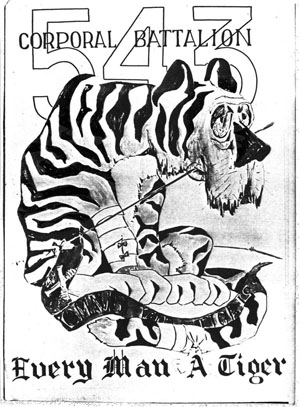 |
|
I was thrilled recently when I found the SETAF website. I was a member of the original 543rd Msl. Bn. (Cpl) when it was formed at Ft. Bliss, TX, in 1955 and with the Battalion when it went to Vicenza, Italy in 1956. Looking over the unit history brought back a lot of memories, so I dug out my photo album that included a number of pictures of those days with the 543rd.
A further note, James Steffes, who was my driver when I was Ammo Train Commander, died of equine encephalitis. Which at the time, at least, was extremely rare.
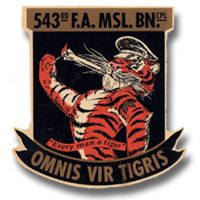 |
|
|
543rd FAM Bn (CPL)
Caserma Ederle, Vicenza |
|
Click on thumbnail to view higher resolution image
|
|
|
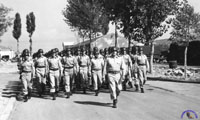
1. Bn Retreat ceremony (KB)
|
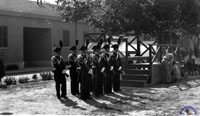
2. Carabinieri at Ederle (KB)
|
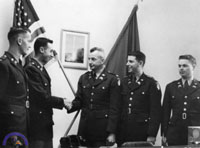
3. Promotion (KB)
|
|
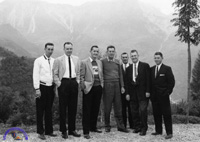
4. Trip to ski resort in the Italian Dolomites (KB) |
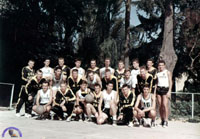
5. Bn basketball team (KB) |
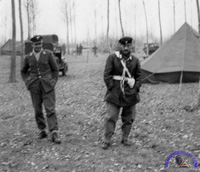
6. Carabinieri in the field with the 543rd (KB) |
|

7. Gen Darby: Putorek & Thomas (KB) |

8. Gen Darby: Gross, Putorek & Thomas (KB) |
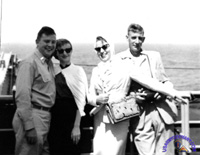
9. Gen Darby: Thomas & Hilditch (KB) |
|
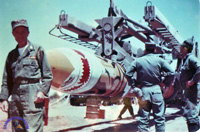
10. White Sands PG: "Flying Tiger" warhead (KB) |
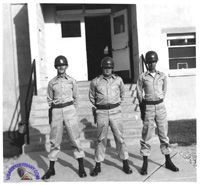
11. Ft. Bliss: Prior to Bn parade (KB) |

12. Ft. Bliss: Best Mess (KB) |
|
|
|
|
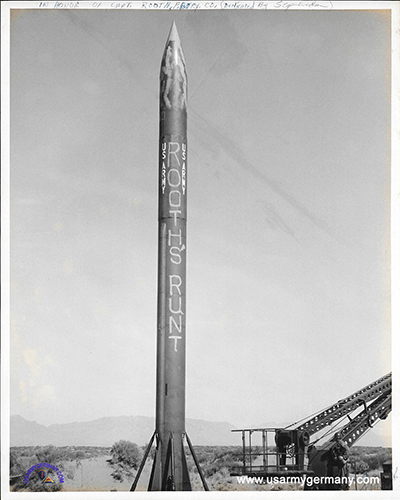
Members of the 543rd FAM are at White Sands Missile Range
for a live firing exercise (James Sepulveda) |
|
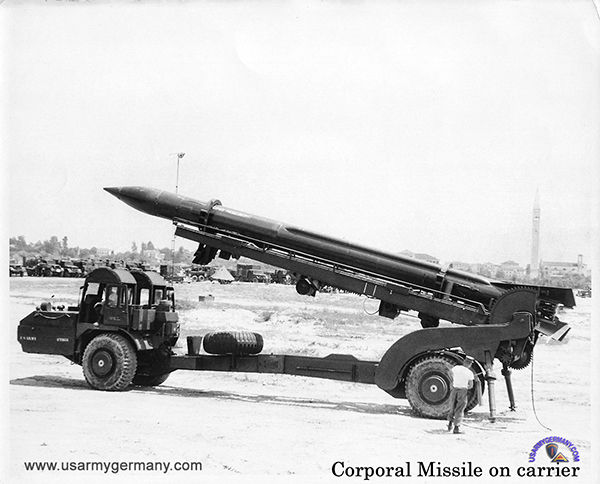
A special purpose LeTourneau Transporter with a CORPORAL missile
at Caserma Ederle (James Sepulveda) |
|

CORPORAL missile orientation (James Sepulveda) |
|
 543rd FA Missile Bn DUI 543rd FA Missile Bn DUI |
|
(Source: Email from James Sepulveda) |
Read your page and searched my old albums. The logo with the smoking tiger on your page was used on our mailing letter head paper and our flag.
Attached you’ll find crest we used on our uniforms.
Somewere in the web I saw the 543rd "Every Man A Tiger" flag and below a shoulder crest. That crest shown belongs to the 570th missile battalion of the 82nd.. |
543rd FAM Bn (CPL)
Caserma Ederle, Vicenza |
|
Click on thumbnail to view higher resolution image
|
|
|
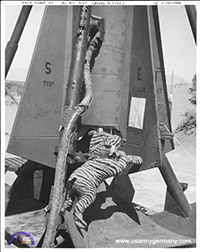
1. Inspection prior to launch
|
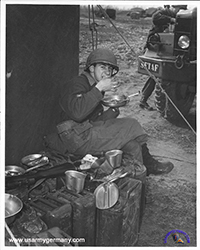
2. Chow time
|

3. Mess tent in the field with US and Italian soldiers
|
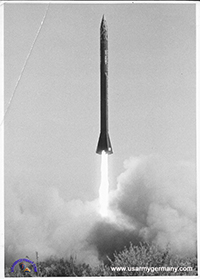
4. Successful launch |
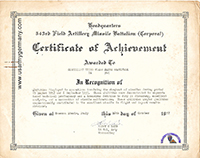
5. Certificate of Achievement |
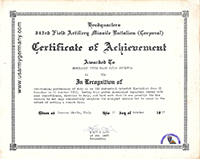
6. Certificate of Achievement |

7. Certificate of Achievement |
|
|
|
| |
| 1st Missile Battalion (Corporal), 82nd Artillery |
|
(Source: Field Artillery, Part 2, Army Lineage Series, compiled by Janice E. McKenney, 2010) |
Battery A, 82d Field Artillery Battalion was redesignated 1 June 1958 as Headquarters and Headquarters Battery, 1st Missile
Battalion, 82d Artillery (organic elements concurrently constituted).
The battalion was activated on 24 June 1958 in Italy.
The battalion was inactivated on 20 April 1964 in Italy. |
 |
|
|
| 570th FA Missile Battalion (Cpl) - 1st Missile Battalion (Cpl), 80th Artillery |
|
| 570th Field Artillery Missile Battalion |
|
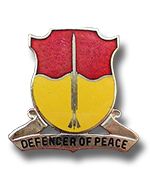 570th FA Missile Bn DUI 570th FA Missile Bn DUI |
|
(Source: Field Artillery, Part 1, Army Lineage Series, 2010) |
The 570th Field Artillery Battalion was relieved from the Army Reserve and allotted to the Regular Army on 13 December 1952.
On
30 August 1955 the battalion was redesignated as the 570th Field Artillery Missile Battalion.
The battalion was activated on 1 September 1955 at Fort Bliss, Texas.
The battalion was inactivated on 24 June 1958 in Italy. |
|
|
| 1st Missile Battalion (Corporal), 80th Artillery |
|
(Source: Field Artillery, Part 2, Army Lineage Series, compiled by Janice E. McKenney, 2010) |
Battery A, 80th Field Artillery Battalion was redesignated 1 June 1958 as Headquarters and Headquarters Battery, 1st Missile Battalion, 80th Artillery (organic elements concurrently constituted).
The battalion was activated on 24 June 1958 in Italy.
The battalion was inactivated on 25 November 1963 in Italy. |
|
|
| 1962 |
(Source Email from Al Wilson, 1st MSL Bn, 80th FA, 1962-64) |
Enjoyed your site, thank you. I was in a Corporal unit (80th Artillery) in Vicenza, Italy from 1962 to 1964. Our unit, along with 82nd Artillery was disbanded just as I was getting an overseas discharge in April of 1964.
Your site (unless I just missed it) did not mention any units in Italy. Good to see history kept alive and as I look back, I think I can qualify as a member of "geezerhood".
Yes, I think we were replaced by the Sergeant missile. I will try to find some info from my days there. I won't have much since I was a draftee and only 2 years of active duty and no wish to go to OCS. I remained a PFC E3 and only made SP4 when I reached my reserve unit in the States. So, with limited responsibilities and on the bottom of the rung I was not in the "loop" to need much information. There just was no rank to be made...
We didn't know it at the time but since the units were to be chucked, was probably why nobody got a rank increase no matter how sharp or eager they might have been. You can imagine how low the moral must have been. We just got to where we didn't care much.
I bought a car and got an overseas discharge and traveled Europe before going home. |
 |
|
|
| 5th MSL Bn, 30th Artillery |
|
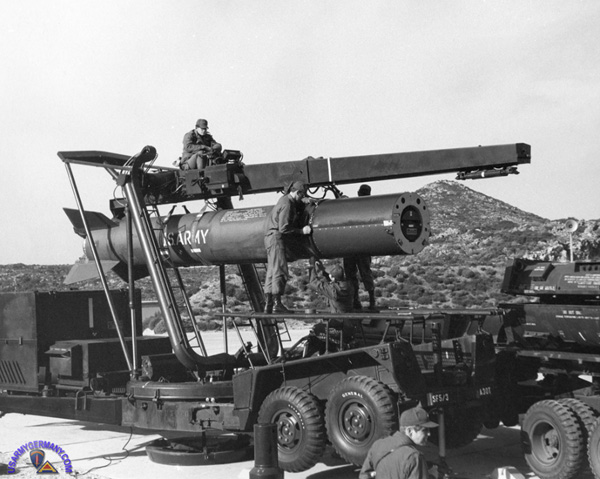
SERGEANT missile launching station of A Btry, 5th Bn, 30th FA (US Army) |
|
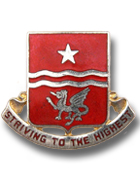 5th Bn, 30th FA DUI 5th Bn, 30th FA DUI |
|
| 1963 |
(Source: Daniel Gillotti) |
The 5th Battalion, 30th Field Artillery was activated at Ft Sill, OK, on 27 February 1963 as a Sergeant Missile Battalion.
The Battalion was deployed to Europe in December 1963, arriving in Vicenza, Italy, on 29 December 1963. 5th Bn, 30th FA was assigned to the 1st Missile Command.
The 5th Bn, 30th FA remained in Italy until it was inactivated in September 1972. |
|
|

A launcher from 5th MSL Bn, 30th Arty on display during an open house (Tom Nash) |
|
(Source: Thoams Nash) |
I was looking the your web site concerning SETAF through the years and the 5th BN 30th Arty (Sergeant Missile).
I was a member of the Ordnance Platoon of H&HB from when the unit was activated at Ft. Sill in June of 1963.
We deployed to Vicenza, Italy in December 1963 to replace the Corporal missile unit there. |
|
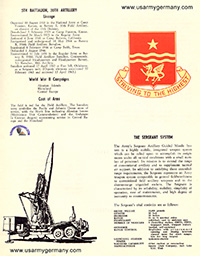
1. Organization Day
|
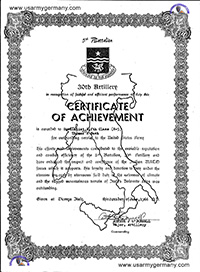
2. Certificate
|
|
|
|
|
|
1972 |
(Source: DANIEL GILLOTTI) |
The 2nd Battalion, 30th Field Artillery was reactivated in Vicenza, Italy in 1972.
On 18 September 1972, the 5th Battalion (Sergeant Missile), 30th Field Artillery was inactivated in Italy and the 2nd Battalion, 30th Field Artillery was reactivated concurrently. All personnel and equipment were transferred in place to the 2nd Bn. On 20 October 1972, LTC Ronald L. Little assumed command of the 2nd Bn.
On 15 Dec 1975, 2nd Battalion, 30th Field Artillery was inactivated in Vicenza, Italy. |
|
|
Photos by Jack Love taken between 1964-66
|
|
|
|
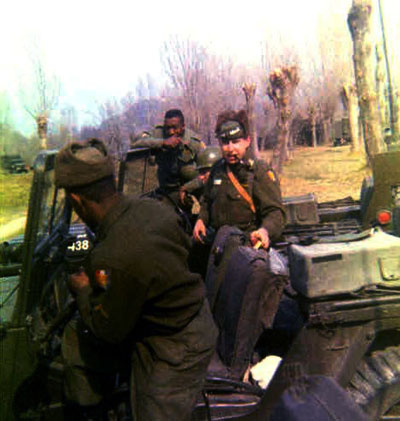
1. Captain Labay
|
|

2. Captain Resodori and 1st Sgt Love, 1965
|
|
|
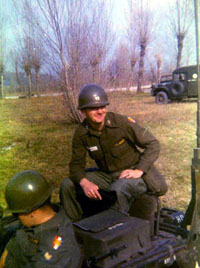
3. Capt Sims |
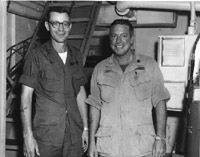
4. CWO Mooreland (right) |
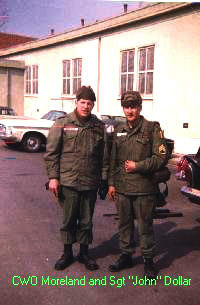
5. Sgt Dollar (right) |
|
|
|
|
Click on thumbnail to view higher resolution image
|
|
|

1. Assembly of missile in front of VIPs (KB)
|

2. Missile demonstration in 1975 (KB)
|
|
|
|
| |
Additional 5/30th FA Photos (a very nice sequence of photos displaying activities at a Sergeant firing battery leading up to the launch) - Hard Chargers web site |
 |
|
|
|
Related
Links
U.S. Army Africa (formerly SETAF)  - Official web site - Official web site
|
| |
|

 543rd FA Missile Bn DUI
543rd FA Missile Bn DUI 570th FA Missile Bn DUI
570th FA Missile Bn DUI
 5th Bn, 30th FA DUI
5th Bn, 30th FA DUI



































